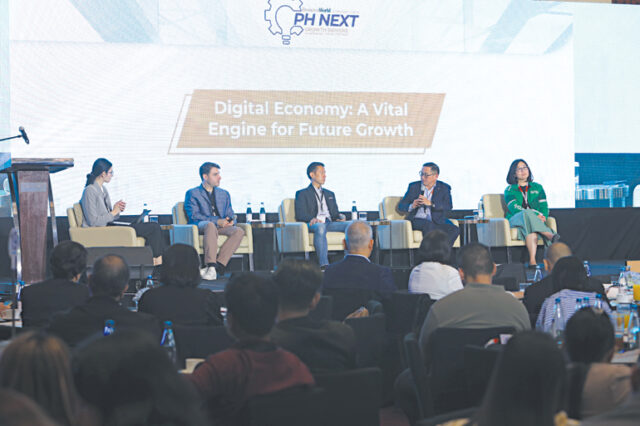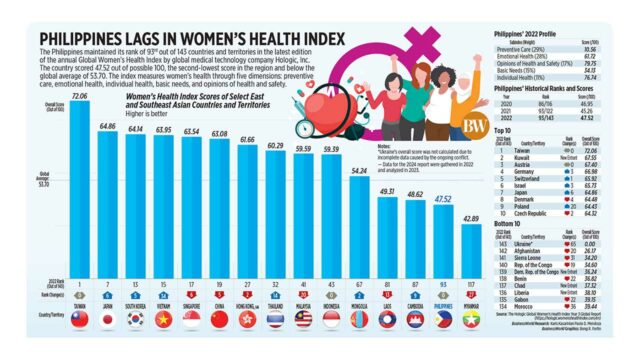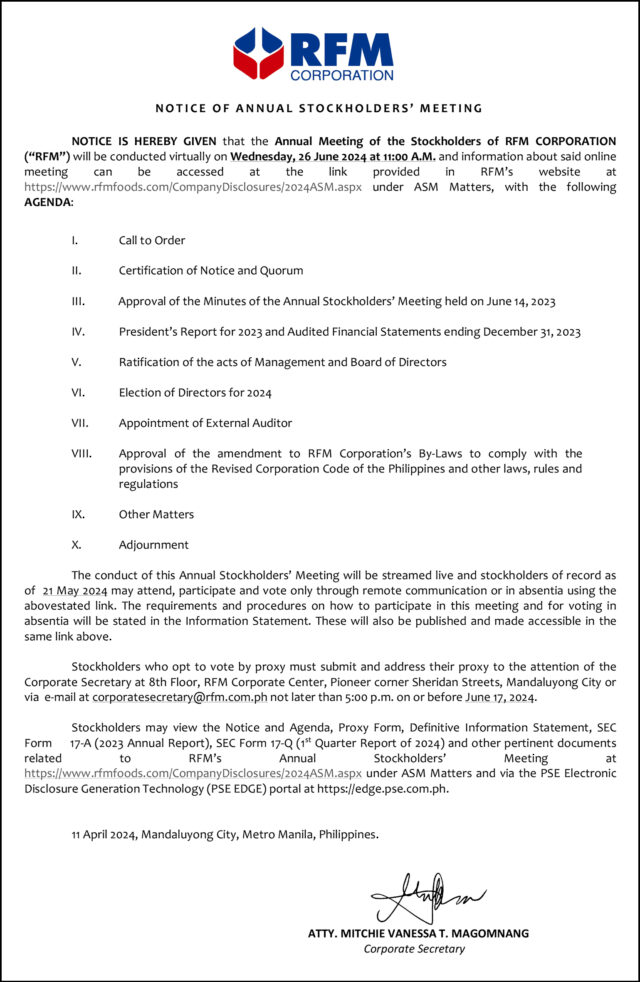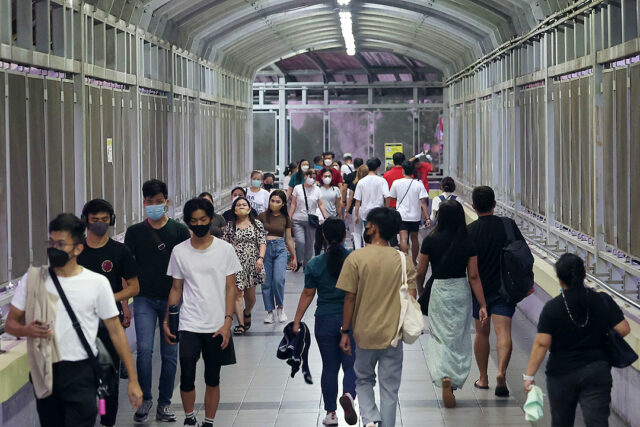Digital economy as fuel for PHL’s development

By Angela Kiara S. Brillantes, Special Features and Content Writer
Digitalization, at this point, is not just a fleeting trend. As the Philippines becomes more digitalized, the shift is propelling industries to adapt and evolve to progress in an ever-changing digital world.
In the panel discussion themed “Digital Economy: A Vital Engine for Future Growth” in this year’s BusinessWorld Economic Forum, experts and executives representing various aspects of the digital economy, such as e-commerce, digital banking, and even mobility, explored the vast potential of the Philippines’ digital economy and how it is expected to steer the overall economy in the years ahead.
The digital economy has emerged as a powerful force in bolstering economic development. For Mitch Padua, group chief product officer at Maya, this is evidenced by 77% of Filipinos found to be already connected online; coupled with P5 trillion worth of money transfers made through InstaPay transactions in 2023; and e-commerce sales projected to reach $24 billion by 2025.
Also witnessing this shift, Jerry G. Ngo, chief executive officer at East West Banking Corp. has noticed the rise towards digital transactions, which has been fueled by increased consumer spending over the years.
“The digital economy is a big enabler to the more robust real economy. For the first time, more than 50% of the transactions have shifted to digital. A lot of it has shifted beyond financial inclusion into financial deepening. If we strip our GDP (gross domestic product), a lot of it is around consumption,” Mr. Ngo said.

“Consumption is not necessarily bad,” he continued. “Consumption is something that happens to you when you’re in a particular life stage; you will consume more because you are young, because you need to build wealth for the next level; and that’s what we need to do. We need to help consumption convert that into wealth and capital that we can then put back to the economy to grow.”
Speaking on the e-commerce side of the digital economy, Carlos Barrera, chief executive officer at Lazada Philippines, said the digital shift has changed the game for e-commerce. Businesses are adopting to digitalization, making more services and products available online.
“Filipinos have that talent to go online, and they are very proficient with using these devices. They are totally native and in many ways are better than people in western countries,” he said.
This demonstrates how people are enamored with the convenience and reliability of e-commerce, as it provides them with effortless means for their needs.

“It has already changed, and people are using online a lot more,” Mr. Barrera added. “People are also flocking towards a lot of the new mechanics online (free shipping, vouchers, etc.) They learned how to optimize all the discounts. The average users of half an hour a day using these apps, [but] they’re not shopping. They check on promotions, add to their cart, share with their friends, use reviews, and watch videos. People are spending more time, even though they are not buying.”
Grace Vera Cruz, country head of Grab Philippines, saw how they can utilize technology to create mobility services and solutions that are affordable and accessible to all, adapting to the ever-changing needs of consumers and the economy.
“For Grab, our solutions are very simple: make every Filipino embrace digital property and infrastructure for their personal growth and the collective progress of our [regime]. Our goal is to push affordability and ensure we reach more consumers on our platform,” she said.
“One of the biggest things we’ve done is make things more affordable, and that’s a key thing we’re trying to do across all of Grab,” the country head added. “We want to make sure that we develop the right sources and solutions that our drivers, merchants, consumers that they can use.”
LEVERAGING TECHNOLOGY
In recent years, a big push for digital innovation is seen in the Philippines, leading to significant progress. This has paved the way for more opportunities and efforts to boost digitalization in the country. One important step to further strengthen this digitalization is by leveraging and investing in technology.
Digital-enabled platforms like Grab and Lazada, for instance, are leveraging artificial intelligence (AI) technology, as their representatives in the panel shared.
Grab, for its part, is using AI in optimizing operations and making its services more efficient and affordable. By embracing emerging technologies like AI, for Ms. Vera Cruz, the Philippines can unlock greater opportunities and enhance economic value in the coming years.

“We’re doing a lot in AI. In Grab, we’ve adopted AI. That’s something we lived by; it’s something required of us. We should be preparing for it and using it to our advantage. Given that a lot of us are digital natives, we all have inherently affinitive towards digital technology, and if we can use that opportunity to learn and win in a world where AI is prevalent, then, that is something we can use to needle in for our economy,” Ms. Vera Cruz said.
Similarly, Lazada has embraced AI and automation in streamlining operations. According to Mr. Barrera, AI will play a significant role in shaping the market and enhancing personalization in the platform. He also mentioned that Lazada is committed to investing in innovative applications like AI to further enhance automation and standardization in its platform.
EXPANDING INVESTMENTS
Meanwhile, in the banking sector, Mr. Ngo of EastWest Bank pointed out the need to ramp up investments to enhance digitalization in the country.
“A lot of innovation is around money and investments,” he explained. “The tech scene is undergoing funding winter. We always follow smart money, and it is out now. We need a fully functioning capital market in order for investors to come in. We need investors, because the amount of money that we need in order to catch up is a lot. We need to understand that we don’t have enough investors locally, we need to open up.”
Maya’s Mr. Padua agreed, noting the need to connect more people and get more industries to digitalize.

“Everyone and everything must be connected,” Mr. Padua pointed out. “There’s still a lot of people and areas that do not have connections. In terms of sectors, there’s still many industries that are still not using digital payments, do not have digital process or websites. We need to invest in innovations. Startups should be thriving. Unfortunately, in the Philippines, access to capital is just not there yet.”
Closing the discussion, the panelists called for continued efforts to unleash the great potential of the digital economy in the Philippines as the country is found to be on the verge of breakthrough.
“There’s a bright future ahead. In the next few years, digital will accelerate and we will see a lot of opportunities coming. The Philippines is at a good position to grow and develop, and we need to continue supporting the growth of economy,” Lazada’s Mr. Barrera said.












